Explore Kharkhorin - Mongolia Travel, Asia
Welcome to Kharkhorin, a historical gem nestled in the heart of Mongolia. Once the vibrant capital of the Mongol Empire under the legendary Genghis Khan, Kharkhorin stands as a testament to Mongolia's rich culture and history. This ancient city has a unique combination of historical significance and stunning scenery, making it a must-see destination for a dream Mongolia trip. As you step into Kharkhorin, you'll go back in time to an era of grand palaces, thriving trade routes, and unparalleled cultural exchange. Whether you're intrigued by ancient ruins, eager to explore local traditions, or simply looking to immerse yourself in Mongolia’s natural beauty, Kharkhorin has something for everyone.
Population: Approximately 1 thousand in 2020.
Economy: One of Mongolia’s most important tourist attractions and the ancient capital of the Mongol Empire.
Landmarks: Famous for the Kharkhorin Ruins, Erdene Zuu Monastery, and the Orkhon Valley-a UNESCO World Heritage Site.
Mongolia
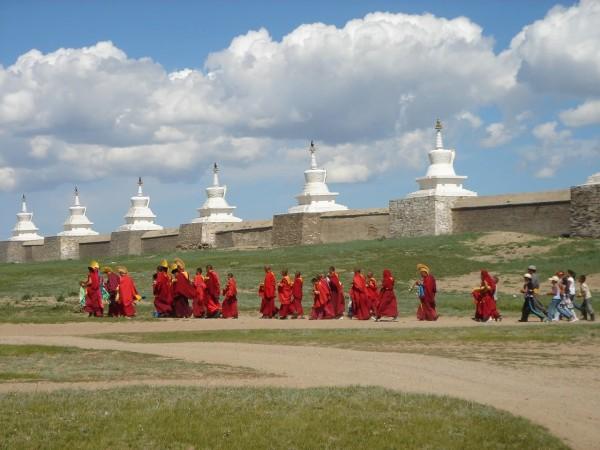
Overview of Kharkhorin
History & Cultural Influence
Kharkhorin's story begins in the 13th century, when it became the capital of the Mongol Empire. Founded by Genghis Khan, the city quickly evolved into a bustling hub of commerce and culture. Its strategic location at the crossroads of ancient trade routes made it a melting pot of diverse influences, from Central Asia to China. The remnants of this rich history can still be felt today. Kharkhorin’s ancient walls, monasteries, and artifacts offer a glimpse into its illustrious past. The city was not just a governmental hub, but also a cultural beacon, drawing intellectuals, craftsmen, and traders from all over the world.
The influence of Kharkhorin's history extends into the present day, shaping Mongolian culture and traditions. The city’s legacy is evident in the local customs, arts, and festivals celebrated by the people of Mongolia. From traditional crafts to the celebration of historical events, Kharkhorin's past continues to inspire and enrich the local culture.
Interaction with The Locals
Kharkhorin, a historic city in Mongolia, has a modest population of approximately 1,000 residents. This small community maintains a blend of traditional Mongolian culture and modern life, offering visitors an authentic glimpse into the local way of life while preserving the city's rich historical heritage. The people of Kharkhorin are known for their warmth and hospitality, offering visitors a genuine taste of Mongolian life. Traditional nomadic lifestyles are still prevalent, and you can experience this firsthand by participating in local customs and celebrations.
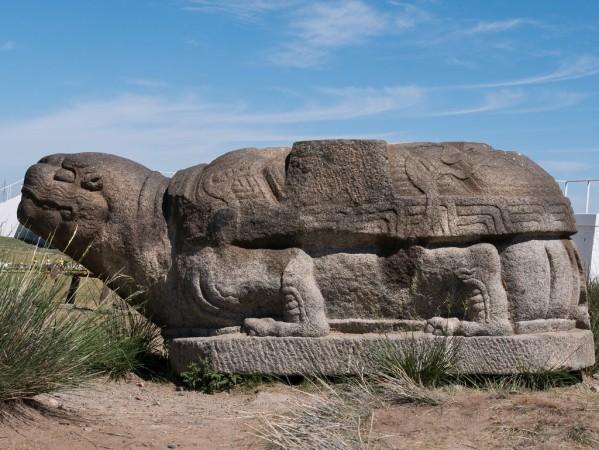
Khorgo Rock - © Flickr
Top Attractions in Kharkhorin
Erdene Zuu Monastery
No trip to Kharkhorin would be complete without seeing the Erdene Zuu Monastery, one of Mongolia's oldest and most important Buddhist monasteries. Founded in the 16th century, this architectural marvel is surrounded by ancient walls and boasts intricate designs that reflect traditional Mongolian Buddhist art. The monastery's tranquil surroundings and historical significance make it a must-see place for your Mongolia trip.
Kharkhorin Museum
For a deeper understanding of Kharkhorin’s past, the Kharkhorin Museum offers an extensive collection of artifacts and exhibits. The museum provides insights into the city's role in the Mongol Empire, showcasing relics, historical documents, and models of ancient architecture. It’s an excellent place to start your journey into the rich history of this legendary city.
Kharkhorin Ruins
The Kharkhorin Ruins are a remarkable monument that preserves the remains of the old Mongol capital. These ruins provide a picture of the city's magnificence at its pinnacle. Wander through the ancient foundations and imagine the bustling life that once thrived here. The site provides an evocative contrast to the more preserved attractions, highlighting the historical evolution of Kharkhorin.
Turtle Rock (Khorgo Rock)
Turtle Rock, located in Kharkhorin, is a spectacular natural feature like a huge turtle. This geological wonder is a popular photo spot and a favorite among nature lovers. The surrounding landscape is equally impressive, with rugged terrain and panoramic views that offer a scenic escape from the city’s historical sites.
Ulaan Tsutgalan Waterfall
Located about 90 kilometers from Kharkhorin, the Ulaan Tsutgalan Waterfall is a stunning natural attraction. Known for its impressive drop and the lush green surroundings, it’s a perfect spot for hiking and picnicking. The waterfall is the most spectacular scene in the spring and summer months, when the water flow is at its highest.
Orkhon Valley
The Orkhon Valley, a UNESCO World Heritage Site, lies near Kharkhorin and is renowned for its cultural and historical significance. The valley is dotted with ancient monuments, including the ruins of early Turkic and Mongol sites. It’s a treasure trove for history buffs and offers breathtaking landscapes that are ideal for outdoor activities like trekking and horseback riding.
Tuvkhun Monastery
Located on a rocky hill, Tuvkhun Monastery is a historical and spiritual place for anyone seeking a peaceful retreat. Founded in the 17th century, this monastery offers spectacular views of the Orkhon Valley and surrounding mountains. The site is significant for its connection to Mongolian Buddhism and its role as a retreat for meditation and reflection.
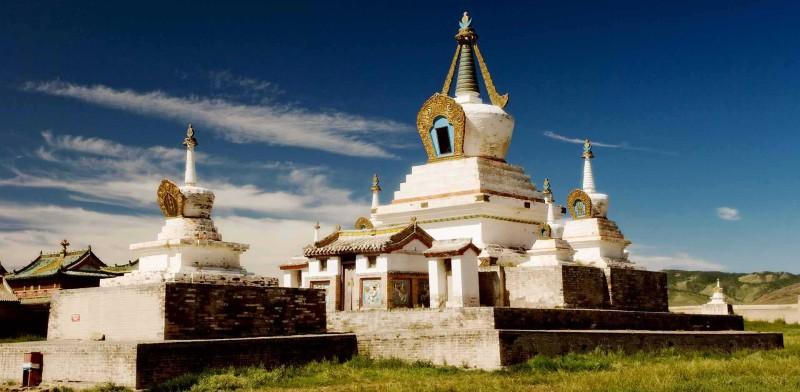
Erdene Zuu Monastery - © Wikimedia
Must-Try Dishes in Kharkhorin
When visiting Kharkhorin, savoring the local cuisine is a must. Mongolian food is hearty, flavorful, and deeply rooted in the country's nomadic traditions.
- Khorkhog: A traditional Mongolian barbecue, Khorkhog is made by cooking meat (often lamb) with hot stones inside a sealed container. The result is a tender, flavorful dish that captures the essence of Mongolian cooking.
- Buuz: These steamed dumplings are filled with minced meat and spices. Buuz are a staple in Mongolian households, often enjoyed during special occasions and festivals.
- Mongolian Barbecue: Although it's known worldwide, the Mongolian barbecue you’ll find in Kharkhorin has an authentic touch, with fresh ingredients and traditional cooking methods.
- Aaruul: Aaruul is a classic dry curd prepared from fermented milk. This chewy, tangy snack is a staple in Mongolian diets, providing essential nutrients and energy. Aaruul is often enjoyed with tea or as a nutritious snack during long journeys.
- Bansh: Similar to Buuz but smaller in size, Bansh are deep-fried dumplings filled with minced meat and spices. They are a popular street food and are typically served with dipping sauces, making them a savory treat for any time of day.
- Khuushuur: Khuushuur are savory pastries filled with spiced minced meat, often lamb or beef, and deep-fried until crispy. These handheld snacks are a common sight at festivals and gatherings, and they offer a crunchy exterior with a juicy filling.
- Mongolian Milk Tea (Suutei Tsai): Suutei Tsai is a traditional Mongolian milk tea made with black tea, milk, and a touch of salt. This comforting beverage is often enjoyed with meals and provides a warm, savory flavor that compliments the hearty nature of Mongolian cuisine.
- Kurut: Kurut is a dried cheese snack made from fermented milk. It has a tangy flavor and a hard, crumbly texture, making it a perfect accompaniment to tea or a quick snack during travels.

Suutei Tsai - © Slurrp
Festivals & Local Celebrations
Kharkhorin is alive with cultural celebrations throughout the year, reflecting Mongolia's rich traditions and vibrant heritage. Here are some key festivals to experience:
- Naadam Festival: This is the most important festival in Mongolia which represents the successful preservation efforts of Mongolian nomadic culture. Taking place in July, Naadam celebrates the "Three Manly Games" of wrestling, horse racing, and archery.
- Tsagaan Sar: The Mongolian Lunar New Year, Tsagaan Sar, marks the beginning of spring and is celebrated with traditional foods, family gatherings, and rituals. It's an excellent opportunity to experience Mongolian friendliness and cultural traditions.
Tourist Activities in Kharkhorin
Outdoor Adventures
- Trekking: Explore the scenic landscapes surrounding Kharkhorin with guided treks that reveal breathtaking views of mountains and valleys.
- Horseback Riding: Experience Mongolia’s nomadic culture firsthand by taking a horseback ride through the picturesque countryside.
Cultural Experiences
- Traditional Music and Dance: Attend performances showcasing traditional Mongolian music and dance, offering insight into the country’s artistic heritage.
- Craft Workshops: Participate in workshops where you can learn about and create traditional Mongolian crafts, such as felt making or wood carving.
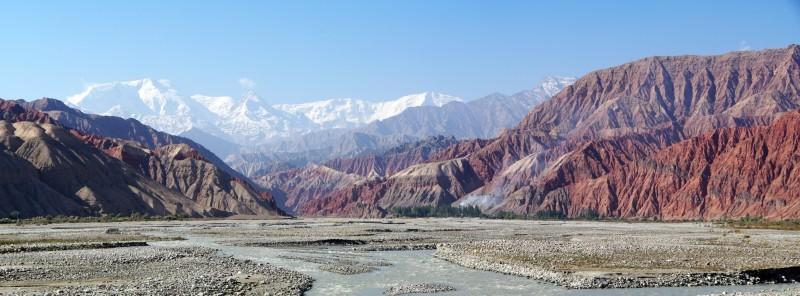
Karakorum Natural Beauty - © Walter Frehner
Weather in Kharkhorin: Best Time to Visit
Spring in Kharkhorin
- Weather: Spring is the transitional season in Mongolia. Temperatures might vary between 5°C and 15°C (41°F to 59°F). This season is marked by the blossoming of flowers and the return of migratory birds, making it an excellent time for nature enthusiasts and photographers.
- Tourism Trend: Spring offers a pleasant climate for exploring the city and nearby attractions, with fewer tourists compared to the summer peak. The weather is generally mild, though it can be unpredictable, so layering clothing is advisable.
Summer in Kharkhorin
- Weather: Summer is the peak travel season in Kharkhorin. With temperatures ranging from 20°C to 30°C (68°F to 86°F), the weather is ideal for outdoor exploration and activities.
- Tourism Trend: This is the best time for trekking, visiting historical sites, and enjoying the lush landscapes surrounding the city. The pleasant weather also makes summer the perfect season for participating in local festivals and cultural events, such as the Naadam Festival.
Autumn in Kharkhorin
- Weather: Autumn in Kharkhorin is characterized by cooler temperatures and vibrant foliage. With temperatures ranging from 10°C to 20°C (50°F to 68°F), the season is great for visiting and viewing the changing colors of Kharkhorin.
- Tourism Trend: This season offers fewer crowds and a more tranquil atmosphere, ideal for those seeking a peaceful getaway. The fresh air and beautiful environment also make outdoor activities like hiking, trekking and photography more enjoyable.
Winter in Kharkhorin
- Weather: Winter brings a magical, snow-covered landscape to Kharkhorin, with temperatures often plunging to -20°C to -30°C (-4°F to -22°F). While this season is cold, it attracts travelers interested in experiencing Mongolia’s serene winter beauty and engaging in winter sports like skiing and snowboarding.
- Tourism Trend: The season is quieter, providing a unique opportunity to explore the city and surrounding areas without the usual tourist bustle. Warm clothing and preparation for cold conditions are essential for winter visitors.
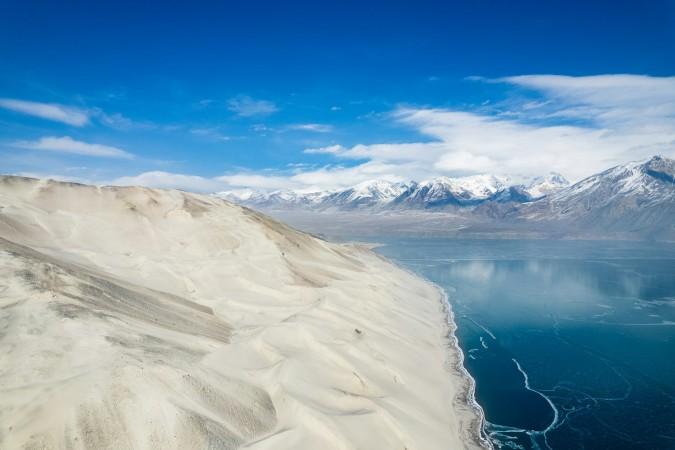
Karakorum in Winter - © darmau
Shopping Experience in Kharkhorin
Kharkhorin’s markets are a vibrant hub for shopping and experiencing local life.
- Kharkhorin Market: This bustling market is the place to shop for traditional Mongolian goods, including handmade crafts, clothing, and souvenirs.
- Local Handicrafts: Look for distinctive Mongolian crafts such as intricate silver jewelry, woolen items, and traditional garments.
When shopping in Kharkhorin, don’t miss out on these special items:
- Cashmere Products: Mongolia is known globally for its high-quality cashmere, contributing a large amount in the continued developing economy of the country. Find luxurious cashmere sweaters, scarves, and shawls as lasting mementos of your trip.
- Traditional Art: Handcrafted items, such as Thangka paintings and traditional Mongolian art, make for unique and meaningful souvenirs.
Culture Etiquette in Kharkhorin
- Respectful Behavior: Understanding and respecting local customs is crucial for a positive experience in Kharkhorin. Here’s a guide to the essential aspects of Mongolian etiquette:
- Greetings: Traditional Mongolian greetings involve placing your hands together in a prayer-like gesture and offering a warm smile. Handshakes are very popular, particularly among guys.
- Dress Code: Dress modestly, particularly when visiting religious sites. Traditional Mongolian attire is appreciated, but casual, respectful clothing is also acceptable.
- Dining Etiquette: When dining, it’s polite to wait for the host to serve you first. It’s customary to finish all the food on your plate as a sign of respect for the meal.
- Photography: Always ask for permission before taking photos of people, especially in rural areas or at religious sites. Respecting this etiquette ensures a positive interaction with locals.
- Gifting Customs: When visiting someone's house or attending a neighborhood event, carrying a modest gift is a considerate gesture. Traditional gifts might include sweets, fruits, or local crafts.
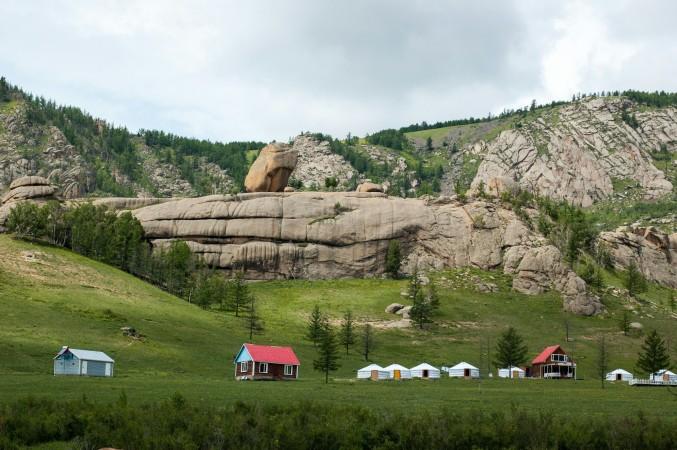
Karakorum nature - © Tuguldur Baatar
Essential Travel Information
Getting Around Kharkhorin
Navigating Kharkhorin and its surroundings is relatively straightforward with various transportation options. Within the city, walking or biking is ideal due to its compact size, and local taxis are available for longer trips or visits to nearby attractions. For exploring the broader Orkhon Valley and surrounding areas, renting a car offers flexibility, though a reliable vehicle is essential, especially in winter. Many visitors also choose guided tours that include transportation and offer in-depth insights into Kharkhorin’s history and culture. Public buses, while limited, provide a budget-friendly option for traveling between major cities and Kharkhorin, though they may be less flexible.
ATM & Banking Services
In Kharkhorin, basic banking and financial services are available but somewhat limited. ATMs are scattered around the central market and key tourist areas, though it's wise to carry some cash as their reliability can vary. Banking services are minimal in the city, with major Mongolian banks located primarily in larger cities like Ulaanbaatar, so visiting these banks before traveling is recommended. Currency exchange services can be found at local hotels and some shops, but the rates may not be as favorable as those in bigger cities.
Where to Stay in Kharkhorin
Kharkhorin offers a variety of accommodation options catering to different preferences and budgets. Local guest houses provide a cozy, authentic experience with traditional Mongolian hospitality. For more comfort, there are several hotels offering amenities ranging from basic to upscale. For a unique experience, traditional ger camps provide a glimpse into Mongolian nomadic life and are set in picturesque locations around the city. Additionally, a few luxury lodges in the area offer high-end amenities and breathtaking views of the surrounding landscapes.
Articles for you

Explore Yala National Park - Sri Lanka Travel, Asia
Tucked away in Sri Lanka’s southeastern corner, Yala National Park is where wild nature meets deep tradition. Known worldwide for its leopard population, the park is also home to elephants, sloth bears, crocodiles, and hundreds of bird species. Beyond wildlife, Yala opens doors to a cultural landscape dotted with ancient temples, Buddhist ruins, and coastal villages. For travelers seeking more than just a safari, Yala offers a chance to explore eco-tourism, local communities, and sacred heritage sites.
Population: The Yala National Park area doesn’t have a human population.
Economy: The economy around Yala National Park thrives on a blend of eco-tourism, agriculture, and local services. Safari tours, eco-lodges, and cultural experiences drive steady income for nearby towns like Tissamaharama and Kataragama, supporting thousands of families.
Landmarks: Famous for Block I of Yala and wildlife encounters, including elephants, sloth bears, crocodiles, and exotic bird species.

Explore Galle - Sri Lanka Travel, Asia
Nestled on Sri Lanka’s southern coastline, Galle is a vibrant city where history meets the sea. Its cobbled streets, colonial architecture, and serene beaches make it a must-visit destination for travelers seeking a blend of culture, adventure, and relaxation. A UNESCO World Heritage site, Galle captivates visitors with its Dutch Fort, bustling markets, and friendly locals. Whether you’re exploring the ramparts at sunset or savoring fresh seafood by the shore, Galle promises an unforgettable journey into Sri Lanka’s heritage.
Population: Approximately 113,000 in 2023.
Economy: Galle’s economy thrives on tourism, trade, and fisheries. The city’s historic fort, colonial architecture, and coastal charm draw thousands of international visitors each year, making tourism its main economic driver. Fishing remains vital for local livelihoods, supplying fresh seafood across the region.
Landmarks: Famous for the Galle Fort, Dutch Reformed Church & Maritime Museum, and Unawatuna Beach.

Explore Bentota - Sri Lanka Travel, Asia
Nestled along Sri Lanka’s southwestern coast, Bentota is a tropical paradise that blends golden beaches, vibrant culture, and thrilling adventures. Famous for its calm waters, luxury resorts, and scenic river estuary, Bentota has become a top destination for travelers seeking both relaxation and authentic experiences. From serene beach walks at sunrise to adrenaline-pumping water sports, this coastal town offers a perfect balance of leisure and exploration. With its proximity to Colombo and Galle, Bentota is easy to reach, making it an ideal stop for both short escapes and extended holidays.
Population: Approximately 37,000 in 2023.
Economy: Bentota’s economy thrives mainly on tourism, which drives local businesses such as hotels, restaurants, and wellness retreats. The town also benefits from fishing, coconut cultivation, and handicrafts like wood carving and batik textiles. Many residents rely on the growing demand for water sports and Ayurvedic treatments, making tourism the backbone of both income and employment in the area.
Landmarks: Famous for Bentota Beach, Bentota River Safari, and Kande Vihara Temple.

Explore Mirissa - Sri Lanka Travel, Asia
Mirissa is a charming coastal town on Sri Lanka’s southern shoreline. Known for its golden beaches, turquoise waters, and vibrant marine life, it has become a must-visit stop for travelers exploring the island. Many come for whale watching, surfing, and sunset views at Coconut Tree Hill, but Mirissa offers much more than postcard beauty. The fishing boats you see anchored by the bay carry generations of stories. Local traditions, delicious cuisine, and a laid-back rhythm of life shape every visitor’s experience.
Population: Approximately 4,700 in 2023.
Economy: Mirissa’s economy is largely shaped by its coastal location. Fishing has long been the backbone of local livelihoods, with generations relying on the Indian Ocean for income. In recent decades, tourism has become the main driver of growth, thanks to whale watching, surfing, and beachside hospitality.
Landmarks: Famous for Mirissa Beach, Coconut Tree Hill, and Parrot Rock Bridge.

Explore Nuwara Eliya - Sri Lanka Travel, Asia
Tucked away in the Central Highlands of Sri Lanka, Nuwara Eliya is often called “Little England”. With its rolling tea plantations, cool misty mornings, and colonial charm, this mountain town feels like a step into another world. Travelers come here to breathe fresh air, walk through flower gardens, sip the finest Ceylon Tea, and enjoy a pace of life far from the island’s busy cities. Whether you’re drawn by scenic landscapes, heritage architecture, or the warmth of its people, Nuwara Eliya is a destination that blends nature, culture, and history in perfect harmony.
Population: Approximately 781,000 in 2023.
Economy: Nuwara Eliya’s economy thrives mainly on tea production, as it sits in the heart of Sri Lanka’s central highlands, famous worldwide for Ceylon Tea. The city also benefits from a growing tourism industry, attracting visitors with its colonial charm, cool climate, and scenic landscapes.
Landmarks: Famous for Gregory Lake, Hakgala Botanical Garden, and Victoria Park.

Explore Sukau - Malaysia Travel, Asia
Nestled on the banks of the Kinabatangan River in Sabah, Malaysian Borneo, Sukau is a destination where wildlife, culture, and conservation come together. Known as one of Asia’s top spots for river safaris and eco-tourism, this quiet village offers a front-row seat to encounters with Bornean orangutans, pygmy elephants, proboscis monkeys, and exotic birdlife.
Population: Approximately 1,400 in 2019.
Economy: Sukau’s economy is shaped by its riverine location and natural resources. Traditionally, the Orang Sungai community relied on fishing, small-scale farming, and forest gathering for their livelihood. Today, the village has shifted toward eco-tourism, with river cruises, jungle trekking, and homestays providing income.
Landmarks: Famous for the Kinabatangan River cruises, Gomantong Caves, and Ox-bow lakes and wetlands.
